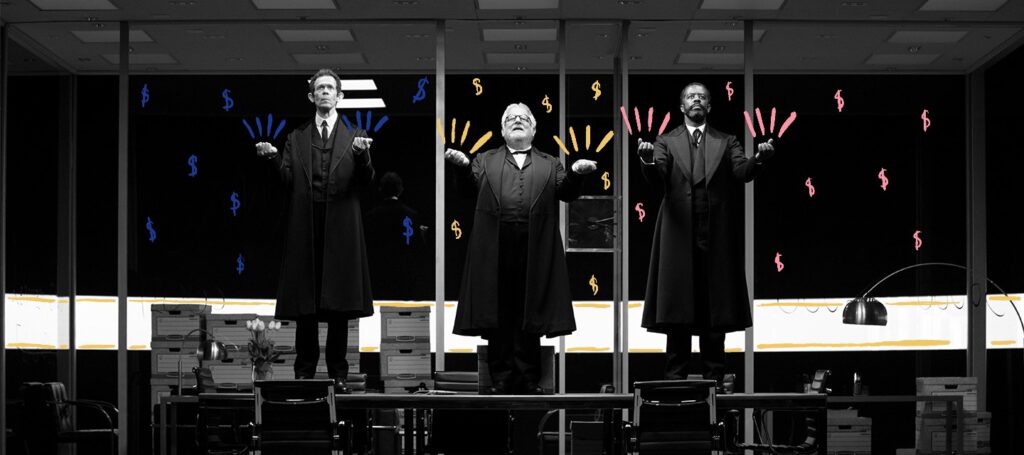


‘The Lehman Trilogy’: Soulless and Expensive Children’s Theatre for Adults
Soulless and expensive―that’s the best way to describe the Broadway debut of The Lehman Trilogy at the David T. Nederlander Theatre. But then, what else should one expect from a 3 hour and 15-minute long theatrical-ish spectacle devoted to the history of one of the world’s largest financial firms?
Es Devlin’s austere corporate office design on a revolving set? Check. A gorgeous stage-length screen that showcases Luke Hall’s videos of burning cotton fields and skyscrapers? That’s here too. How about luxury casting, featuring three Olivier award-nominated and winning actors: Simon Russell Beale, Adam Godley, and Adrian Lester, all of whom are on hand as Lehman’s multi-character playing narrators. It’s even got sure-to-win-an-award direction from the acclaimed director Sam Mendes.
But what about dramatic tension or characters that one cares about?
Sorry, you’ll have to go elsewhere if you’re looking for that.
Caring about the characters and their exploits might have been possible if Lehman’s script―written by Stefano Massini and adapted from Italian by Ben Power―hadn’t adopted a by-the-numbers, theatre-as-a-Wikipedia-article approach to telling its story. Or if its characters didn’t constantly telegraph and narrate the action as it was occurring to them. But they do, and it’s all a pity because the actors are quite good, even though they never entirely overcome the pretensions of live-action role-playing a script that has more in common with a novel than it does a play.
The plot, such as it is, slogs through more than 170 years of historical exposition as we are told, and shown, how the original three Lehman brothers found their success―first by selling cloth, though soon afterward as the original financial “middlemen”―and raised their successors to pursue ever-greater profits. A key factor in the storytelling is watching the actors repurpose modern-day office supplies in service of their era’s exploits―be that creating platforms, buildings, reams of cloth, or store signs. This occurs repeatedly throughout all three acts of the play.
For all of his delightful inventiveness, Mendes fails to address Lehman’s lack of dramatic tension. Perhaps he hoped that by keeping the wheels constantly turning, the audience would fail to notice that nothing theatrically compelling occurs in the bloated data-filled story. Bob Fosse accomplished the same thing with his “all the world’s a circus” approach to the musical Pippin. Mendes almost gets away with it here but is undercut by Massini’s framing—that the Lehman family’s success was a foregone conclusion. There is no space for losers here; only victorious blokes about whom we can read in a simple internet search.
The real question is, why should anyone care about their catalog of wins if no time was going to be invested in analyzing the emotional costs of their devotion to capitalism? While there is a passing reference to the sins of slavery in Act I, as well as signs that these decidedly hetero characters sacrificed their families to success, when it comes to matters of the heart, there is simply no pulse.
Instead of character-defining traits, we are shown repetitive sequences that frequently occur in precisely the same manner regardless of who is doing what―though that “what” is usually proposing a marriage, business deal, or new initiative. It’s all terribly clever and droll until the lack of variety or specificity in the text begins to grate.
Lehman is at its most abrasive when depicting women. While I initially enjoyed watching Beale and Godley mince as bonny lasses, I grew weary of their antics once it emerged that the script saw its women as nothing more than trophies or circumstances to be overcome.
This is no fault of the actors. They are all simply marvelous, though watching them execute children’s theatre for adults feels like an opulent waste. As wasteful as observing Lester place a gun in his mouth and blow his head off, repeatedly―the only actor to do so―in imitation of the mass suicides that occurred after the stock market crash of 1929.
That sight gets to the cluelessness of this production: it seems that no one considered that celebrating the play’s recreation of Black Tuesday by having the show’s sole Black man inflict gun violence on himself during this current political moment might be a bad look. As with so much in this production, it is likely that no one in the (all white) creative team cared because, like the story, they were more concerned with impressing the audience with a soulless recitation of capitalism’s glory.
Despite my observations, the (mostly white) audience at the performance I attended enjoyed themselves immensely and frequently laughed as if the show’s stale repetition were a breath of fresh air. Perhaps all that glitters is in fact gold.
Keep Reading

‘Thoughts of a Colored Man’ Falters and It Should Be Allowed To
Very few pieces of contemporary art show us Black men who are alive, on the “right” side of the law, and (in their own ways) thriving. ‘Thoughts of a Colored Man’, directed by Steve H. Broadnax III, and written by Keenan Scott II, does. Performed by seven phenomenal actors, the play centers on a cross-section […]
Read More
‘Is This A Room’ Puts Reality on Stage
Reality has become a tricky, increasingly-elusive concept. With heavily-edited “reality” television, overly-curated social media profiles, and politically-minded accusations of “fake news,” the definition of what counts as “reality” is hazy at best. Is This A Room, conceived and directed by Tina Satter, puts this debate center stage by using an FBI interrogation transcript as the […]
Read More












